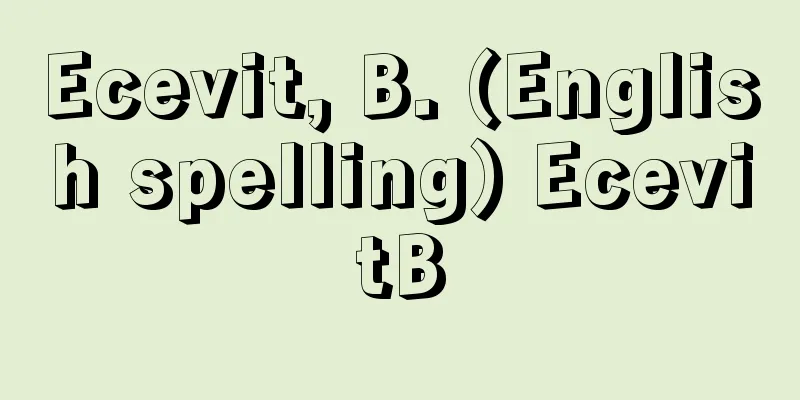Pastel - Pastel (English spelling)

|
A type of art material used in Western painting for sketching. Chalk powder or other pigments solidified with a water-soluble binder are collectively called sticky chalk (artificial chalk), and among these, the relatively softer ones are generally called pastels. However, it is difficult to tell whether a drawing was made with natural or artificial chalk, so it is usually referred to simply as chalk, or by specifying the color, such as black chalk or white chalk. It seems that the term pastel is limited to multi-colored art materials that clearly have the powdery softness that is unique to this material. Attempts to make pastels were made relatively early, and they were already being used for drawing in the early 16th century. The word pastel first appeared in documents at the end of the 16th century, and there is evidence that it had spread not only to Italy but also to Northern Europe by that time. However, hard chalk was overwhelmingly preferred until the 18th century. The pigments that produce the colors in pastels are almost the same as those in paints, but by simply changing the ratio of two or three types of pigments, an astonishing number of colors can be produced. The condition for obtaining good quality pastels lies rather in the binder. Each pigment has its own unique viscosity and adhesion, so the binder must be adjusted according to the pigment. The types of binders that appear in old documents are extremely diverse, and often mysterious. These include sugar candy, gum arabic, gum tragacanth (a resin from a legume found in Asia Minor and Persia), milk, whey (a liquid separated from curds during cheese making), fig sap, beer, malt juice, glue, animal urine, honey, paste, gypsum, etc. In modern times, gum tragacanth became the basic binder, but today it has been replaced by methylcellulose. It was not until the 18th century that pastel's color and softness began to be fully utilized in drawings, and it was especially popular with French painters. In the second half of the 19th century, Degas produced heavy, painterly works using pastels, but Renoir, Mary Cassatt, and Toulouse-Lautrec also produced many excellent drawings using this medium. The widespread use of pastels can be attributed to improvements in the quality of the medium itself, as well as the development of fixatives to preserve the artwork. [Haruki Yaegashi] "Pastel Painting Tools and Techniques" edited by the Technique Series Editorial Office (1979, Bijutsu Shuppansha) " ▽ "Pastel Painting Techniques" by Toshio Okazaki (1981, Yuzankaku) They come in a variety of shapes and hardness. The top left and bottom right are soft pastels, the top right is semi-hard pastels, and the bottom left is pastel pencils. ©Shogakukan "> pastel 1885-1888 Pastel, Metropolitan Museum of Art Degas "Race Horse" Source: Shogakukan Encyclopedia Nipponica About Encyclopedia Nipponica Information | Legend |
|
西洋画の画材の一種で、素描に用いられる。チョークの粉末などの顔料(がんりょう)を水溶性のつなぎ剤で固めたものを粘(ねば)りチョーク(人造チョーク)と総称するが、このうち比較的柔らかいものを一般にパステルとよぶ。しかし、素描が天然あるいは人造チョークのどちらで描かれたかを判別するのはむずかしく、単にチョーク、または色を特定して黒チョーク、白チョークのように表記するのが普通である。パステルと表記されるのは、多色で、この画材独特の粉っぽい柔らかさが明確なものに限られるようである。 パステル製造の試みは比較的早く、16世紀初めにはすでに素描に用いられていた。パステロpastelloということばが文献に登場するのは16世紀末で、このころにはイタリアのみならず、北ヨーロッパにも広まった形跡がある。しかし、18世紀までは硬質のチョークのほうが圧倒的に好まれた。パステルの発色材となる顔料は、具体的には絵の具のそれとほとんど同じだが、2、3種類の顔料の配合比を変えるだけで、驚くほど多くの色彩が生まれる。良質のパステルを得るための条件はむしろつなぎ剤にある。顔料はそれぞれ固有の粘性と固着性があるため、つなぎ剤は各顔料に応じて調整しなければならない。古い文献にみえるつなぎ剤の種類は実に多様で、しばしば神秘的ですらある。すなわち、砂糖飴(あめ)、アラビアゴム、トラガカントゴム(小アジア、ペルシアに産するマメ科植物の樹脂)、ミルク、ホエイ(チーズ製造時に凝乳から分離した液)、イチジクの樹液、ビール、麦芽汁、膠(にかわ)、獣尿、蜂蜜(はちみつ)、糊(のり)、焼石膏(しょうせっこう)などである。近代ではトラガカントゴムが基本的つなぎ剤となったが、今日ではメチルセルロースがそれにかわっている。 パステルの発色と柔らかさが素描作品に十分に発揮されるようになるのは18世紀になってのことで、とりわけフランスの画家たちに好まれた。19世紀後半、ドガはパステルによる絵画的な重厚な作品を生み出したが、ルノワール、メアリー・カサット、ロートレックらもこの画材を用いて優れた素描を数多く残している。パステルが多用されるようになった背景には、それ自体の質的向上のほかに、作品保存のためのフィクサティーフ(とめニス)の開発が考えられる。 [八重樫春樹] 『技法叢書編集室編『パステル画の用具と描き方』(1979・美術出版社)』▽『岡崎利雄著『パステル画の技法』(1981・雄山閣)』 形も硬さもさまざまなものがある。左上と右下がソフトパステル、右上がセミハードパステル、左下がパステル鉛筆©Shogakukan"> パステル 1885~1888年ころ パステルメトロポリタン美術館所蔵"> ドガ『競走馬』 出典 小学館 日本大百科全書(ニッポニカ)日本大百科全書(ニッポニカ)について 情報 | 凡例 |
<<: Boris Leonidovich Pasternak
>>: Basse Terre (English spelling)
Recommend
Grudge - Onnen
〘 noun 〙 A feeling of resentment. A feeling of res...
Luzarches, R.de (English spelling) LuzarchesRde
…Most of the building was constructed between 122...
Helmet
...The term blizzard is now commonly used to desc...
The Constitution of the Athenians
In addition to these, he had written other works ...
Spirit Cave - Spirit Cave (English spelling)Spirit
This cave site is located near Mae San Nam village...
Pendulum scale - Pendulum scale
A general term for scales that use a pendulum in t...
Sodium alkyl ether sulfate - Sodium alkyl ether sulfate
…(1) Dishwashing detergents must be safe, not dam...
Nanban chickweed - Nanban chickweed
A perennial plant of the Caryophyllaceae family (...
Koibaly
…Turkic-speaking herders who live in the area of ...
Mount Kamon
...At the summit is an elliptical caldera that is...
Buddhist robes - Kyoe
" Shroud Today's coat " Same as &quo...
Yoshikazu Satake
A feudal lord in the late Edo period. The 9th feu...
Organ culture - Kikanbaiyou
A method of culturing parts of animals and plants...
Spitsbergen
…It became a Norwegian territory in 1925. There a...
Katyayaniputra (English spelling)
…He belongs to the Sarvastivada school, a branch ...









